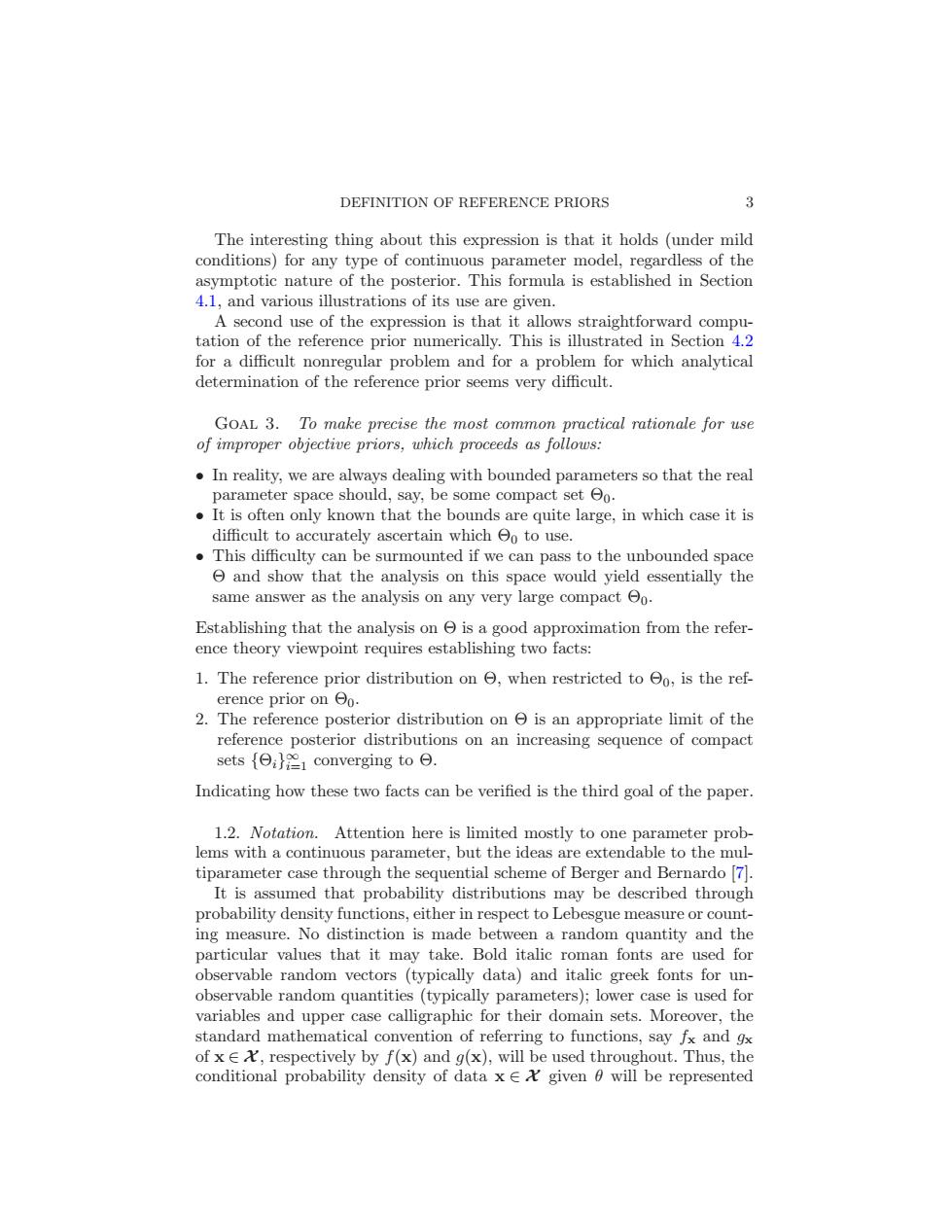正在加载图片...

DEFINITION OF REFERENCE PRIORS 3 The interesting thing about this expression is that it holds (under mild conditions)for any type of continuous parameter model,regardless of the asymptotic nature of the posterior.This formula is established in Section 4.1,and various illustrations of its use are given. A second use of the expression is that it allows straightforward compu- tation of the reference prior numerically.This is illustrated in Section 4.2 for a difficult nonregular problem and for a problem for which analytical determination of the reference prior seems very difficult. GOAL 3.To make precise the most common practical rationale for use of improper objective priors,which proceeds as follows: In reality,we are always dealing with bounded parameters so that the real parameter space should,say,be some compact set o. It is often only known that the bounds are quite large,in which case it is difficult to accurately ascertain which o to use. This difficulty can be surmounted if we can pass to the unbounded space and show that the analysis on this space would yield essentially the same answer as the analysis on any very large compact Oo Establishing that the analysis on is a good approximation from the refer- ence theory viewpoint requires establishing two facts: 1.The reference prior distribution on e,when restricted to eo,is the ref- erence prior on 0o. 2.The reference posterior distribution on e is an appropriate limit of the reference posterior distributions on an increasing sequence of compact sets f:converging to e. Indicating how these two facts can be verified is the third goal of the paper. 1.2.Notation.Attention here is limited mostly to one parameter prob- lems with a continuous parameter,but the ideas are extendable to the mul- tiparameter case through the sequential scheme of Berger and Bernardo [7]. It is assumed that probability distributions may be described through probability density functions,either in respect to Lebesgue measure or count- ing measure.No distinction is made between a random quantity and the particular values that it may take.Bold italic roman fonts are used for observable random vectors (typically data)and italic greek fonts for un- observable random quantities (typically parameters);lower case is used for variables and upper case calligraphic for their domain sets.Moreover,the standard mathematical convention of referring to functions,say fx and gx of xE,respectively by f(x)and g(x),will be used throughout.Thus,the conditional probability density of data x E&given 6 will be representedDEFINITION OF REFERENCE PRIORS 3 The interesting thing about this expression is that it holds (under mild conditions) for any type of continuous parameter model, regardless of the asymptotic nature of the posterior. This formula is established in Section 4.1, and various illustrations of its use are given. A second use of the expression is that it allows straightforward computation of the reference prior numerically. This is illustrated in Section 4.2 for a difficult nonregular problem and for a problem for which analytical determination of the reference prior seems very difficult. Goal 3. To make precise the most common practical rationale for use of improper objective priors, which proceeds as follows: • In reality, we are always dealing with bounded parameters so that the real parameter space should, say, be some compact set Θ0. • It is often only known that the bounds are quite large, in which case it is difficult to accurately ascertain which Θ0 to use. • This difficulty can be surmounted if we can pass to the unbounded space Θ and show that the analysis on this space would yield essentially the same answer as the analysis on any very large compact Θ0. Establishing that the analysis on Θ is a good approximation from the reference theory viewpoint requires establishing two facts: 1. The reference prior distribution on Θ, when restricted to Θ0, is the reference prior on Θ0. 2. The reference posterior distribution on Θ is an appropriate limit of the reference posterior distributions on an increasing sequence of compact sets {Θi}∞ i=1 converging to Θ. Indicating how these two facts can be verified is the third goal of the paper. 1.2. Notation. Attention here is limited mostly to one parameter problems with a continuous parameter, but the ideas are extendable to the multiparameter case through the sequential scheme of Berger and Bernardo [7]. It is assumed that probability distributions may be described through probability density functions, either in respect to Lebesgue measure or counting measure. No distinction is made between a random quantity and the particular values that it may take. Bold italic roman fonts are used for observable random vectors (typically data) and italic greek fonts for unobservable random quantities (typically parameters); lower case is used for variables and upper case calligraphic for their domain sets. Moreover, the standard mathematical convention of referring to functions, say fx and gx of x ∈ X , respectively by f(x) and g(x), will be used throughout. Thus, the conditional probability density of data x ∈ X given θ will be represented